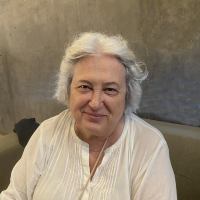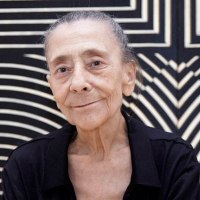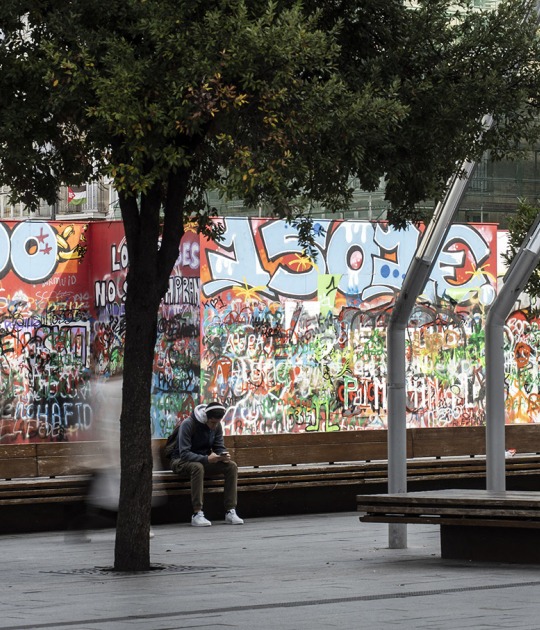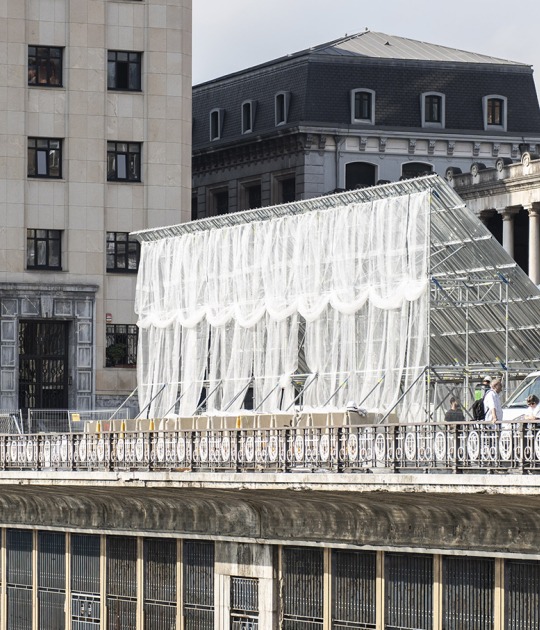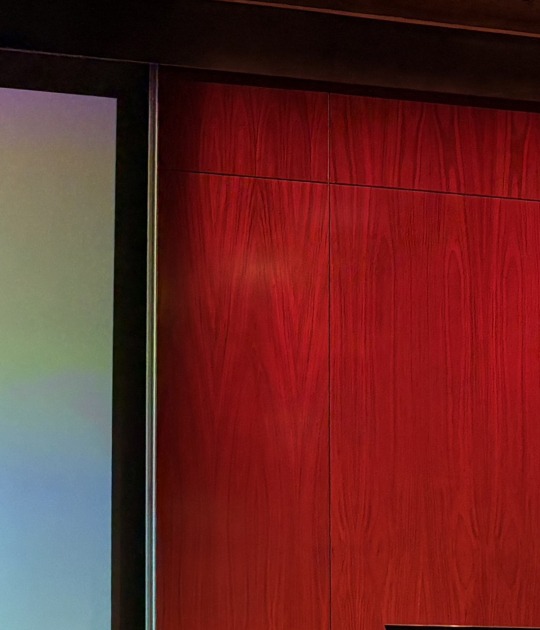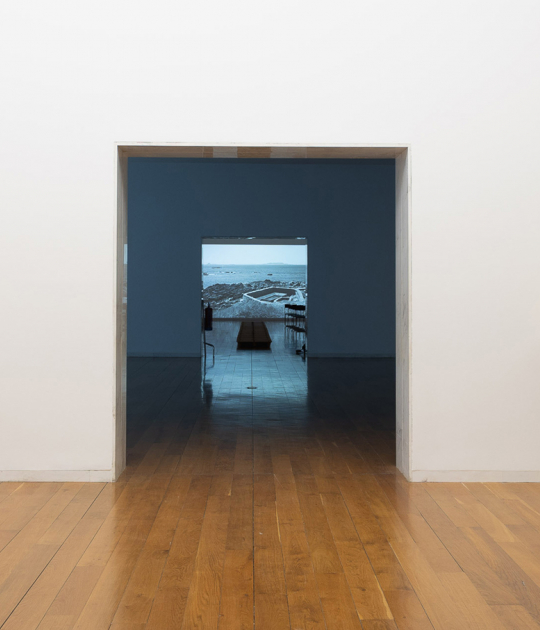
Elena Asins (Madrid, 1940 – Navarra, 2015). Untitled, 1978. Engraving, 69 x 49 cm, work shared in a private collection(s), Madrid.
Dear Narelle:
I have been reflecting on what we saw and talked about at the Elvira González Gallery in front of the work of Elena Asins.
With all this in mind, I have looked at our piece (Asins 2) again. I have realized that it superimposes the spaces that will end up leading it to the piece Canons de Zarautz (1996) and that it develops in much of the work on display, for example, in the piece at the entrance to the exhibition (Asins 1). In such spaces she combines the two and three dimensions and, with it, is simultaneously inside and outside of them. In our piece, by superimposing them, she manages, in addition to combining the two-dimensional with the three-dimensional and the inside with the outside, also the depth thereby including the space. A kiss, Capi, San Lorenzo del Escorial, May 3, 2024.
(Dear c., Thank you and as you said specifically, the Menhirs (and dolmens) came from there too... n) message from her on the same day.

So far untitled (The English Way), 2024 by Narelle Jubelin. Flooring with insulating bricks of 25 x 10 x 12 cm c/u, variable dimensions. In Aínda sen título. White Letter [#3] to Narelle Jubelin. (Elena Asins · Narelle Jubelin · Anna Turbau). Photograph by Roi Alonso, courtesy of Nordes Gallery.
NJ > AT “Do you remember yesterday when you were talking about the highway? You said something about archaeology. You said something about the neighbours, I don't know if they had seen something 'disrupted', [destroyed]?

Mobilizacións contra AP-9. Rande, 1977 (From the series Obras da autoestrada AP-9). Galicia, 1977-78. Contact sheets. 21 selected images. Pigmented ink giclée print on Fine Art Nature paper. 50 x 70 cm (Ed. 1/5). 2024. In Aínda sen título. White Letter [#3] to Narelle Jubelin. (Elena Asins · Narelle Jubelin · Anna Turbau). Photograph by Roi Alonso, courtesy of Nordes Gallery.
This material is 50 years old but I have to tell you that now they have put a highway in Soria, near my town, and it turns out that it crosses a Roman road, one of the most important and there has been a huge mess, they have had to do a whole series of earthworks and such. They cut it, but, in exchange, they have made some viewpoints so that you can see, very well done with a lot of intelligence... and some things have stopped, that cannot be touched. On the other hand, on the highway, they put in machines and used dynamite in brutal quantities, and the houses shook. There are plenty of photos of large cracks. For me, it was a change that marked the limits of how, from then on, there were minimums that had to be met.

Nueva Forma (From the Afterimage series, 2011-2012) by Narelle Jubelin. Six interpretations in petit point of cotton and silk mounted between glasses, 90x65x25mm c/u. 2012. In Aínda sen título. White Letter [#3] to Narelle Jubelin. (Elena Asins · Narelle Jubelin · Anna Turbau). Photograph by Roi Alonso, courtesy of Nordes Gallery.
Subtitles or bullet points: like the pretitle, they are not essential textual elements but can help to impact and summarize in very few lines (max. 3 bullet points) the core of the entire press release. • citing reference(s) • on resistance(s) • on ‘transmission paths’.
In Aínda sen title. Carta Blanca [#3] we enter a space or as Elena Asins would say we enter an 'habitacle' where dissonances, jobs, intimate relationships, deep-rooted values and beliefs coexist; and we consider how the gallery shapes the lived experience. Until the summer of 2024, we merge experimental, contemporary and historical works in dialogue.
This exhibition will be accompanied by a conversation in the gallery space, during June, where we will consider what the works have to say to each other.
Other readings:
•Anna Turbau: Galicia, 1975-1979 [Legacy of Anna Turbau to the Consello da Cultura Galega] Editor and coordinator, Natalia Poncela López; texts, Emilio Grandío, Margarita Ledo Andión, Rebeca Pardo, Natalia Poncela López, Cristina Zelich; traducciones, Cristina Río López, Gary Smith. ISBN 978-84-92923-86-1
•Narelle Jubelin. Nalgures [Exhibition catalog 03.06.22/ 16.10.22, CGAC] Editor and coordinators, Elena Expósito, Natalia Poncela. Consellería de Cultura, Educación, Formación Profesional e Universidades, Xunta de Galicia, Santiago de Compostela, 2024. ISBN 978-84-453-5473-5
10 HIGHWAYS; 12 OCCUPATION OF RANDE BRIDGE, PONTEVEDRA 23/OCTOBER/77; 13 PICKET STEW 1/DECEMBER/77; 17 PICKET STEW; 24 ASSEMBLY CECEBRE 26/FEBRUARY/78; 25 NEIGHBORS OF ORTO AND CECEBRE; 27 WORKS IN VILABOA, DISASSEMBLY RIO MAYOR PIPE APRIL/78; 29 VISIT TO THE HIGHWAY COORDINATOR BY DEPUTIES BUSSELO (PSOE) AND RIVAS (UCD) SAN ADRIAN 7/MAY/78; 30 WOUNDED SALT JUNE/78; 32 DEMONSTRATION “RANDE BRIDGE OPENING SCALETRIX DEMOLITION” VIGO 9/JULY/78; 35 RAND BRIDGE JULY/78.

![Aínda sen título. White Letter [#3] to Narelle Jubelin. (Elena Asins · Narelle Jubelin · Anna Turbau). Photograph by Roi Alonso, courtesy of Galería Nordés. Aínda sen título. White Letter [#3] to Narelle Jubelin. (Elena Asins · Narelle Jubelin · Anna Turbau). Photograph by Roi Alonso, courtesy of Galería Nordés.](/sites/default/files/styles/mopis_news_carousel_item_desktop/public/metalocus_narelle-jubellin_carta-aberta_07.jpg?itok=1u8ASBkZ)


![Aínda sen título. White Letter [#3] to Narelle Jubelin. (Elena Asins · Narelle Jubelin · Anna Turbau). Photograph by Roi Alonso, courtesy of Galería Nordés. Aínda sen título. White Letter [#3] to Narelle Jubelin. (Elena Asins · Narelle Jubelin · Anna Turbau). Photograph by Roi Alonso, courtesy of Galería Nordés.](/sites/default/files/styles/mopis_news_carousel_item_desktop/public/metalocus_narelle-jubellin_carta-aberta_04.jpg?itok=72RbqCRI)
![Aínda sen título. White Letter [#3] to Narelle Jubelin. (Elena Asins · Narelle Jubelin · Anna Turbau). Photograph by Roi Alonso, courtesy of Galería Nordés. Aínda sen título. White Letter [#3] to Narelle Jubelin. (Elena Asins · Narelle Jubelin · Anna Turbau). Photograph by Roi Alonso, courtesy of Galería Nordés.](/sites/default/files/styles/mopis_news_carousel_item_desktop/public/metalocus_narelle-jubellin_carta-aberta_13.jpg?itok=Uka62QrG)
![Aínda sen título. White Letter [#3] to Narelle Jubelin. (Elena Asins · Narelle Jubelin · Anna Turbau). Photograph by Roi Alonso, courtesy of Galería Nordés. Aínda sen título. White Letter [#3] to Narelle Jubelin. (Elena Asins · Narelle Jubelin · Anna Turbau). Photograph by Roi Alonso, courtesy of Galería Nordés.](/sites/default/files/styles/mopis_news_carousel_item_desktop/public/metalocus_narelle-jubellin_carta-aberta_14.jpg?itok=06KWFdF2)
![Aínda sen título. White Letter [#3] to Narelle Jubelin. (Elena Asins · Narelle Jubelin · Anna Turbau). Photograph by Roi Alonso, courtesy of Galería Nordés. Aínda sen título. White Letter [#3] to Narelle Jubelin. (Elena Asins · Narelle Jubelin · Anna Turbau). Photograph by Roi Alonso, courtesy of Galería Nordés.](/sites/default/files/styles/mopis_news_carousel_item_desktop/public/metalocus_narelle-jubellin_carta-aberta_07a_0.jpg?itok=IkvcXEA2)
![Aínda sen título. White Letter [#3] to Narelle Jubelin. (Elena Asins · Narelle Jubelin · Anna Turbau). Photograph by Roi Alonso, courtesy of Galería Nordés. Aínda sen título. White Letter [#3] to Narelle Jubelin. (Elena Asins · Narelle Jubelin · Anna Turbau). Photograph by Roi Alonso, courtesy of Galería Nordés.](/sites/default/files/styles/mopis_news_carousel_item_desktop/public/metalocus_narelle-jubellin_carta-aberta_08.jpg?itok=Gfb8gINb)
![Aínda sen título. White Letter [#3] to Narelle Jubelin. (Elena Asins · Narelle Jubelin · Anna Turbau). Photograph by Roi Alonso, courtesy of Galería Nordés. Aínda sen título. White Letter [#3] to Narelle Jubelin. (Elena Asins · Narelle Jubelin · Anna Turbau). Photograph by Roi Alonso, courtesy of Galería Nordés.](/sites/default/files/styles/mopis_news_carousel_item_desktop/public/metalocus_narelle-jubellin_carta-aberta_09.jpg?itok=7KxHb6ME)
![Aínda sen título. White Letter [#3] to Narelle Jubelin. (Elena Asins · Narelle Jubelin · Anna Turbau). Photograph by Roi Alonso, courtesy of Galería Nordés. Aínda sen título. White Letter [#3] to Narelle Jubelin. (Elena Asins · Narelle Jubelin · Anna Turbau). Photograph by Roi Alonso, courtesy of Galería Nordés.](/sites/default/files/styles/mopis_news_carousel_item_desktop/public/metalocus_narelle-jubellin_carta-aberta_24.jpg?itok=Nl5gHxa5)
![Petit Points by Narelle Jubelin. Aínda sen título. White Letter [#3] to Narelle Jubelin. (Elena Asins · Narelle Jubelin · Anna Turbau). Photograph by Roi Alonso, courtesy of Galería Nordés. Petit Points by Narelle Jubelin. Aínda sen título. White Letter [#3] to Narelle Jubelin. (Elena Asins · Narelle Jubelin · Anna Turbau). Photograph by Roi Alonso, courtesy of Galería Nordés.](/sites/default/files/styles/mopis_news_carousel_item_desktop/public/metalocus_narelle-jubellin_carta-aberta_26.jpg?itok=Gm3qAGph)
![Petit Points by Narelle Jubelin. Aínda sen título. White Letter [#3] to Narelle Jubelin. (Elena Asins · Narelle Jubelin · Anna Turbau). Photograph by Roi Alonso, courtesy of Galería Nordés. Petit Points by Narelle Jubelin. Aínda sen título. White Letter [#3] to Narelle Jubelin. (Elena Asins · Narelle Jubelin · Anna Turbau). Photograph by Roi Alonso, courtesy of Galería Nordés.](/sites/default/files/styles/mopis_news_carousel_item_desktop/public/metalocus_narelle-jubellin_carta-aberta_27.jpg?itok=pGFZlgsB)
![Petit Points by Narelle Jubelin. Aínda sen título. White Letter [#3] to Narelle Jubelin. (Elena Asins · Narelle Jubelin · Anna Turbau). Photograph by Roi Alonso, courtesy of Galería Nordés. Petit Points by Narelle Jubelin. Aínda sen título. White Letter [#3] to Narelle Jubelin. (Elena Asins · Narelle Jubelin · Anna Turbau). Photograph by Roi Alonso, courtesy of Galería Nordés.](/sites/default/files/styles/mopis_news_carousel_item_desktop/public/metalocus_narelle-jubellin_carta-aberta_28.jpg?itok=puF3fIGI)
![Petit Points by Narelle Jubelin. Aínda sen título. White Letter [#3] to Narelle Jubelin. (Elena Asins · Narelle Jubelin · Anna Turbau). Photograph by Roi Alonso, courtesy of Galería Nordés. Petit Points by Narelle Jubelin. Aínda sen título. White Letter [#3] to Narelle Jubelin. (Elena Asins · Narelle Jubelin · Anna Turbau). Photograph by Roi Alonso, courtesy of Galería Nordés.](/sites/default/files/styles/mopis_news_carousel_item_desktop/public/metalocus_narelle-jubellin_carta-aberta_29.jpg?itok=nKhgVgly)
![Petit Points by Narelle Jubelin. Aínda sen título. White Letter [#3] to Narelle Jubelin. (Elena Asins · Narelle Jubelin · Anna Turbau). Photograph by Roi Alonso, courtesy of Galería Nordés. Petit Points by Narelle Jubelin. Aínda sen título. White Letter [#3] to Narelle Jubelin. (Elena Asins · Narelle Jubelin · Anna Turbau). Photograph by Roi Alonso, courtesy of Galería Nordés.](/sites/default/files/styles/mopis_news_carousel_item_desktop/public/metalocus_narelle-jubellin_carta-aberta_30.jpg?itok=EA1sz8lT)
![Petit Points by Narelle Jubelin. Aínda sen título. White Letter [#3] to Narelle Jubelin. (Elena Asins · Narelle Jubelin · Anna Turbau). Photograph by Roi Alonso, courtesy of Galería Nordés. Petit Points by Narelle Jubelin. Aínda sen título. White Letter [#3] to Narelle Jubelin. (Elena Asins · Narelle Jubelin · Anna Turbau). Photograph by Roi Alonso, courtesy of Galería Nordés.](/sites/default/files/styles/mopis_news_carousel_item_desktop/public/metalocus_narelle-jubellin_carta-aberta_31.jpg?itok=KV_-6nnH)








![Aínda sen título. White Letter [#3] to Narelle Jubelin. (Elena Asins · Narelle Jubelin · Anna Turbau). Photograph by Roi Alonso, courtesy of Galería Nordés. Aínda sen título. White Letter [#3] to Narelle Jubelin. (Elena Asins · Narelle Jubelin · Anna Turbau). Photograph by Roi Alonso, courtesy of Galería Nordés.](/sites/default/files/styles/mopis_news_carousel_item_desktop/public/metalocus_narelle-jubellin_carta-aberta_03.jpg?itok=JDt5wZhF)
![Aínda sen título. White Letter [#3] to Narelle Jubelin. (Elena Asins · Narelle Jubelin · Anna Turbau). Photograph by Roi Alonso, courtesy of Galería Nordés. Aínda sen título. White Letter [#3] to Narelle Jubelin. (Elena Asins · Narelle Jubelin · Anna Turbau). Photograph by Roi Alonso, courtesy of Galería Nordés.](/sites/default/files/styles/mopis_news_carousel_item_desktop/public/metalocus_narelle-jubellin_carta-aberta_06.jpg?itok=Ae4VTJZw)
![Aínda sen título. White Letter [#3] to Narelle Jubelin. (Elena Asins · Narelle Jubelin · Anna Turbau). Photograph by Roi Alonso, courtesy of Galería Nordés. Aínda sen título. White Letter [#3] to Narelle Jubelin. (Elena Asins · Narelle Jubelin · Anna Turbau). Photograph by Roi Alonso, courtesy of Galería Nordés.](/sites/default/files/styles/mopis_news_carousel_item_desktop/public/metalocus_narelle-jubellin_carta-aberta_05.jpg?itok=TuBG2jew)
![Aínda sen título. White Letter [#3] to Narelle Jubelin. (Elena Asins · Narelle Jubelin · Anna Turbau). Photograph by Roi Alonso, courtesy of Galería Nordés. Aínda sen título. White Letter [#3] to Narelle Jubelin. (Elena Asins · Narelle Jubelin · Anna Turbau). Photograph by Roi Alonso, courtesy of Galería Nordés.](/sites/default/files/styles/mopis_news_carousel_item_desktop/public/metalocus_narelle-jubellin_carta-aberta_01.jpg?itok=D1aO6p9H)
![Aínda sen título. White Letter [#3] to Narelle Jubelin. (Elena Asins · Narelle Jubelin · Anna Turbau). Photograph by Roi Alonso, courtesy of Galería Nordés. Aínda sen título. White Letter [#3] to Narelle Jubelin. (Elena Asins · Narelle Jubelin · Anna Turbau). Photograph by Roi Alonso, courtesy of Galería Nordés.](/sites/default/files/styles/mopis_news_carousel_item_desktop/public/metalocus_narelle-jubellin_carta-aberta_10.jpg?itok=m2310RY0)
![Aínda sen título. White Letter [#3] to Narelle Jubelin. (Elena Asins · Narelle Jubelin · Anna Turbau). Photograph by Roi Alonso, courtesy of Galería Nordés. Aínda sen título. White Letter [#3] to Narelle Jubelin. (Elena Asins · Narelle Jubelin · Anna Turbau). Photograph by Roi Alonso, courtesy of Galería Nordés.](/sites/default/files/styles/mopis_news_carousel_item_desktop/public/metalocus_narelle-jubellin_carta-aberta_11.jpg?itok=zWTpHJDy)
![Aínda sen título. White Letter [#3] to Narelle Jubelin. (Elena Asins · Narelle Jubelin · Anna Turbau). Photograph by Roi Alonso, courtesy of Galería Nordés. Aínda sen título. White Letter [#3] to Narelle Jubelin. (Elena Asins · Narelle Jubelin · Anna Turbau). Photograph by Roi Alonso, courtesy of Galería Nordés.](/sites/default/files/styles/mopis_news_carousel_item_desktop/public/metalocus_narelle-jubellin_carta-aberta_12.jpg?itok=miIJVQmP)



